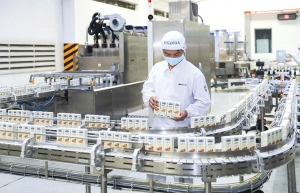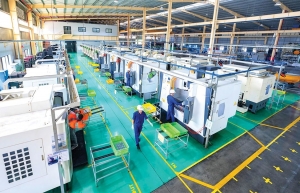Businesses becoming active in the circular economy
The European Union is slated to pilot the Carbon Border Adjustment Mechanism (CBAM) from October, aligned with its vision of achieving carbon neutrality by 2050. How do you anticipate the CBAM to impact Vietnam?
 |
| Melissa MacEwen, sustainability and circular economy director for PwC in Asia-Pacific |
There are five key sectors under which products are going to be affected, and when products from those areas are imported into the EU, there will be checks based on emissions intensity.
This will require independent verification, something which Vietnamese enterprises must prepare for. There are regulations in Vietnam regarding reduction of greenhouse gas emissions and protection of the ozone layer, but they do not yet include independent verification.
The CBAM is also an opportunity to keep money within the country. Taking Thailand as an example, this country actually already responded to the potential impact of the CBAM on its sectors and is applying a tax on the same sectors within Thailand.
The great thing about the CBAM is that it allows a business to prove that it already paid tax based on its emissions intensity in its home country. If that is the case and its taxes are verified, then they don’t also have to pay it to the EU. This is a really useful way of keeping that capital within Vietnam and it can be reinvested here, rather than going over to Europe. So maybe that’s something the government can pick up.
Many Vietnamese companies have products that will be impacted by the CBAM, such as fertilisers, steel, and chemicals, among others. What would be your strategic advice to such enterprises?
Hopefully, Vietnamese businesses are already reporting on their emissions. Because the CBAM requires independent verification, they need to make sure that all their data collection is robust and can be independently verified, so that they don’t lose access to the EU.
In the longer term, in terms of the costs, businesses need to look at how they can reduce the emissions intensity of their products. If they reduce the emissions intensity, then the certificate or the tax that they need to pay will come down.
Obviously, that is a little bit more of a longer-term strategy, but it’s worth starting to think about right now. This will avoid additional costs over many, many years.
Last month, 14 associations stated that a new draft on recycling costs set rates that are “unreasonably high, even higher than some European countries”. How would these proposed rates impact the bottom line for businesses and for Vietnam’s circular economy development in general?
I cannot comment on the impact of recycling cost rates on specific companies’ bottom lines, as this requires case-by-case analysis. However, it is reasonable to expect that as the circular economy scales, increased costs associated with recycling and recycled materials will come down, similar to how technology costs in the renewable energy transition are coming down.
How have other countries effectively integrated circular economy principles into their national policies, and what kind of incentives have proven effective for businesses?
More than 50 national circular economy roadmaps and strategies have been launched globally, and a further 520+ circular economy-related policies (for example, plastic taxes, bans, and extended producer responsibility schemes) now exist.
Integration of circular economy principles into existing climate change policies and cooperation between business and environment ministries will be crucial, as will effective communication between business sectors and the government when designing policies and schemes, so that practical implementation is at the front of everyone’s mind.
Financial instruments such as tax incentives and subsidies can be made available for technological upgrades and applications of the circular economy, such as in waste management. Preferential access to land for businesses which incorporate circular principles into their operations are also examples of ways in which circularity can be encouraged.
What role has tech innovation played in the transition to a circular economy, and how can Vietnam harness such technologies?
Technological upgrades and innovation have an important role to play in the circular transition. On a fundamental level, upgraded machinery can ensure the highest levels of efficiency in production processes.
Beyond that, the incorporation of Industry 4.0 technologies such as digital twin tech and deep learning sensors can be used to analyse production processes in VR with practical applications for predictive maintenance of machinery and reducing the volume of defective products, to name some examples.
 | Key enterprises plug circular economy shift Company leaders have highlighted the need for a balanced approach of incentives and penalties as Vietnam’s business community explores a circular economy model. |
 | Robust strategy can aid circular economy Vietnam’s ambition to build a circular economy will be backed by a national action plan, with specific criteria for businesses to join and apply related solutions. |
What the stars mean:
★ Poor ★ ★ Promising ★★★ Good ★★★★ Very good ★★★★★ Exceptional
Related Contents
Latest News
More News
- From compliance to strategy: ESG criteria gaining ground (September 29, 2025 | 15:47)
- Vietnamese firms step up ESG game (September 23, 2025 | 15:26)
- Vietnam tax and legal changes set to shape foreign investment landscape (September 16, 2025 | 13:46)
- Vietnamese businesses navigate US tariffs (June 25, 2025 | 12:14)
- The impact of cloud, AI, and data on financial services (April 14, 2025 | 11:20)
- Vietnam 2025 M&A outlook: trends, deals, and opportunities (March 21, 2025 | 08:54)
- Vietnam's M&A landscape mirrors global trends (February 18, 2025 | 17:13)
- Asia-Pacific CEOs enter 2025 with optimism and caution (February 06, 2025 | 17:16)
- Proposed changes to interest deductibility rules may be welcomed by taxpayers (January 22, 2025 | 09:23)
- PwC Vietnam holds Hack A Day 2024 to nurture IT and cybersecurity talents (November 14, 2024 | 12:24)

 Tag:
Tag:




















 Mobile Version
Mobile Version